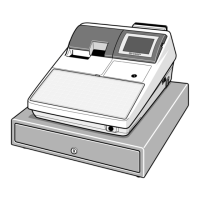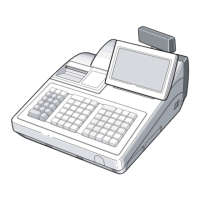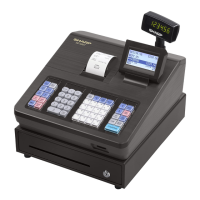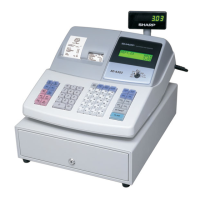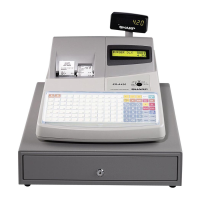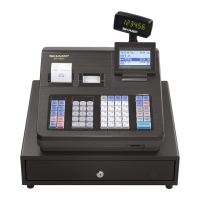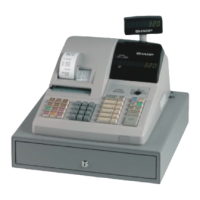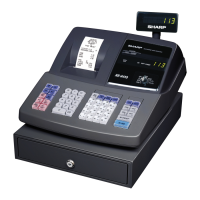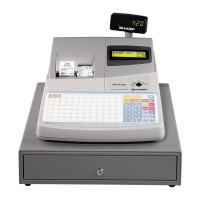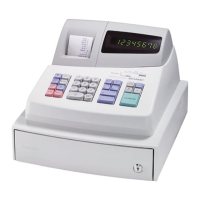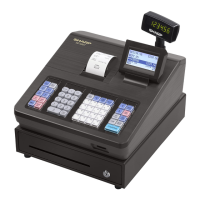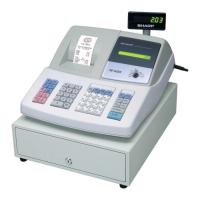4. MAIN LSI DESCRIPTION
1) CPU (SH7014)
1)-1. SH7014 Overview
The SH7014 CMOS single-chip microprocessors integrate a Hitachi-
original architecture, high-speed CPU with peripheral functions re-
quired for system configuration.
The CPU has a RISC-type instruction set. Most instructions can be
executed in one clock cycle, which greatly improves instruction exe-
cution speed. In addition, the 32-bit internal-bus architecture en-
hances data processing power. With this CPU, it has become possi-
ble to assemble low cost, high performance/high-functioning systems,
even for applications that were previously impossible with microproc-
essors, such as real-time control, which demands high speeds. In
particular, the SH7040 series has a 1-kbyte on-chip cache, which
allows an improvement in CPU performance during external memory
access.
In addition, this LSI includes on-chip peripheral functions necessary
for system configuration, such as large-capacity ROM (except the
SH7014, which is ROMless) and RAM, timers, a serial communica-
tion interface (SCI), an A/D converter, an interrupt controller, and I/O
ports. Memory or peripheral LSIs can be connected efficiently with an
external memory access support function.
This greatly reduces system cost.
1)-1-1. SH7014 Features
CPU:
• Original Hitachi architecture
• 32-bit internal data bus
• General-register machine
– Sixteen 32-bit general registers
– Three 32-bit control registers
– Four 32-bit system registers
• RISC-type instruction set
– Instruction length: 16-bit fixed length for improved code effi-
ciency
– Load-store architecture (basic operations are executed be-
tween registers)
– Delayed branch instructions reduce pipeline disruption during
branch
– Instruction set based on C language
• Instruction execution time: one instruction/cycle (35 ns/instruction
at 28.7-MHz operation)
• Address space: Architecture supports 4 Gbytes
• On-chip multiplier: multiplication operations (32 bits x 32 bits 64
bits) and multiplication/accumulation operations (32 bits x 32 bits +
64 bits
64 bits) executed in two to four cycles
• Five-stage pipeline
Cache Memory:
• 1-kbyte instruction cache
• Caching of instruction codes and PC relative read data
• 4-byte line length (1 longword: 2 instruction lengths)
• 256 entry cache tags
• Direct map method
• On-chip RAM, and on-chip I/O areas not objects of cache
• Used in common with on-chip RAM; 2 kbytes of on-chip RAM used
as address array/data array when cache is enabled
Interrupt Controller (INTC):
• Seven external interrupt pins (NMI, IRQ x 6)
• Twenty-eight internal interrupt sources
• Sixteen programmable priority levels
Bus State Controller (BSC):
• Supports external extended memory access
– 8-bit, or 16-bit external data bus
• Memory address space divided into five areas (four areas of
SRAM space, one area of DRAM space) with the following settable
features:
– Number of wait cycles
– Outputs chip-select signals for each area
– During DRAM space access:
• Outputs RAS and CAS signals for DRAM
• Can generate a RAS precharge time assurance Tp cycle
• DRAM burst access function
– Supports high-speed access mode for DRAM
• DRAM refresh function
– Programmable refresh interval
– Supports CAS-before-RAS refresh and self-refresh modes
• Wait cycles can be inserted using an external WAIT signal
• Address data multiplex I/O devices can be accessed
Note: No bus release
Direct Memory Access Controller (DMAC) (2 Channels):
• Supports cycle-steal and burst transfers
• Supports single address mode and dual address mode transfers
• Priority order: fixed at channel 0 > channel 1
• Transfer counter: 16 bits
• Transfer request sources: external DREQ input, auto-request, and
on-chip supporting modules
• Address space: 4 Gbytes
• Choice of 8-, 16-, or 32-bit transfer data size
Multifunction Timer/Pulse Unit (MTU) (3 Channels):
• Maximum 8 types of waveform output or maximum 16 types of
pulse I/O processing possible based on 16-bit timer, 3 channels
• 8 dual-use output compare/input capture registers
• 8 independent comparators
• 8 types of counter input clock
• Input capture function
• Pulse output mode
– One shot, toggle, PWM
>>>>> USE FONT <<<<<
Helvetica/ Helvetica-Condensed/ Century-Schoolbook/ Symbol & OriginalFonts: (RingWorld2/RingFont2/Pa
Symbol/PartsCod)
- - - - - - - - - - - - - - - - - - - - - - - - - - - - - - - - - - - - - - - - - - - - - - - - - - - - - - -
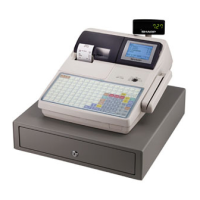
